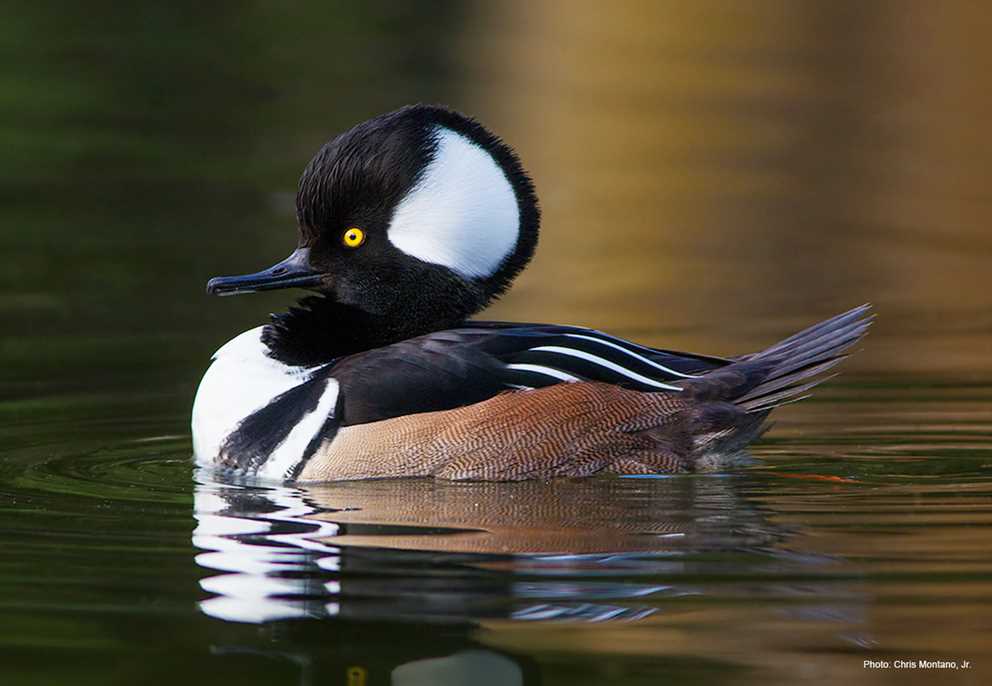Overview
Hooded Mergansers are the smallest of the three merganser species and poorly studied compared to most other waterfowl. Their range is restricted to North America. Breeding birds occur in two disjunct areas – throughout the east (roughly east of the Missouri River and Mississippi below its confluence with the Missouri, but including most of Missouri, Arkansas and Louisiana) where they reach their highest breeding density, and in the Pacific Northwest, including British Columbia, western Montana, northern Idaho, Washington, and portions of Oregon. Hooded Mergansers are cavity nesters and readily use constructed nest boxes.
Males are easily distinguished by the white, fan-shaped crest on their black head. The neck and back are black, with long white and black tertial feathers, the sides are brown, but have notable black and white vertical stripes towards the breast, and the belly and breast are white. The bill is narrow and black. Females are brown-gray overall with a gray-brown crest, a white belly, and a narrow yellow gray bill. Nests are associated with forested wetlands throughout their range.
Description
Key Identification Features:
- Hooded mergansers are medium-sized sea ducks, and the smallest of the three merganser species in North America.
- In winter, males are easily distinguished by the white, fan-shaped crest on their black head. The neck and back are black, with long white and black tertial feathers, the sides are brown, but have notable black and white vertical stripes towards the breast, and the belly and breast are white. The bill is narrow and black.
- Females are brownish gray overall, with a gray-brown crest that may appear lighter brown towards the back, a white belly, and a narrow yellow gray bill.
Male/Female Average Length and Weight
- Mass: Males 1.5 lbs.; Females 1.2
- Wing length: Males 7.5–8.2; Females 7.1–7.5 in.
Male Identification:
- Alternate (Breeding) Plumage: The head and neck are black, with a large white, wedge-shaped patch behind the eye (forms a thin white line when feathers are depressed), white breast and belly, sides with a white and black vertical stripe and then brown, back black with black and white tertial feathers. The bill is narrow and black with a notable black nail.
- Basic Plumage: Overall brownish-gray, white belly.
Female Identification:
- Alternate (Breeding) Plumage: Overall brownish gray to gray, with a notable brown crest that may become lighter towards the back of the head. Belly white, billow, dark yellow gray with a relatively large nail.
- Basic Plumage: Overall brownish-gray, white belly.
In-Flight Identification:
- Male: Male is mainly black and brown with a white belly, has a rounded tail, white patterning on head and inner upper wing parts, fast wingbeats.
- Female: Female is similar to the male but no white patch on head and overall brown rather than mainly black and brown.
Vocalizations:
- Male Calls: Males in courtship may emit a frog like “craaa-oooo” when doing head throw display.
- Female Calls: Females give harsh “crooooak” when alarmed.
Similar Species:
- Wood Ducks: Maybe confused with Wood Ducks in poor light, and because of habitat preference overlap. Hooded mergansers are slenderer, with faster, choppy wing beats in flight compared to wood ducks, and they and show more white on the wings in flight than wood ducks.
Habitat Preferences
- Breeding: Breeding Hooded Mergansers are typically found on freshwater forested wetlands.
- Migration and Wintering: In migration and winter, they use forested wetlands but may also be seen on freshwater ponds, lakes, and rivers, and occasionally in brackish bays and estuaries. Sometimes seen pursuing schools of shad in large foraging flocks on inland lakes in winter.
Foraging Habits and Diet
- Hooded mergansers have a more diverse diet than the other two species of mergansers in North America. They are visual predators and forage extensively on fish, aquatic insects, and crustaceans (especially crayfish) throughout the annual cycle.
Breeding Habits
- Monogamy: Hooded Mergansers are seasonally monogamous, with presence of longer-term pair bonds not documented but possible.
- Nest Locations: Hooded Mergansers nest in cavities, and will readily use constructed nest boxes. Females do not add material to cavity nests.
- Clutch Size: Averages of 9 to 12 eggs. Female may also lay in nests of other females, resulting in abnormally larger clutch sizes up to 26 eggs. The white eggs are spherical, with shells much thicker than Wood Duck eggshells, and average 2.1 by 1.7 in. The incubation period is 29 to 33 days. They are not known to renest unless nest loss occurs during laying.
Migration & Distribution
- Fall Migration: Birds residing at southern latitudes may be considered resident and non-migratory. Otherwise, poorly documented but Hooded Mergansers probably depart breeding wetlands in October or November depending on latitude.
- Spring Migration: Spring migration March-April with arrival on breeding areas in May or early June.
Conservation Status
- IUCN Status: Least Concern
- Population Status: The North American population estimate is roughly 300,000–400,000 on birds, but it is difficult to survey these dwellers of forested wetlands. Limited data suggests that the population is stable.
- Conservation Concerns: The primary threats include loss of habitat, pollution, and habitat degradation.
- Conservation Focus: Conservation efforts focus on protecting habitat, provision of nest boxes, and monitoring Hooded Merganser populations.
Harvest Information
- An average of 78,669 Hooded Mergansers were harvested per season across the United States during the 2019 through 2022 hunting seasons.
- Hooded Merganser harvest is typically highest in the Mississippi Flyway, accounting for 50 to 60 percent of the total United States harvest.
- The top three harvest states for Hooded Mergansers across the 2019 –2022 hunting seasons were North Carolina (38,212), Minnesota (36,974), and Michigan (19,301).





